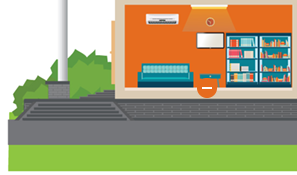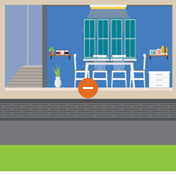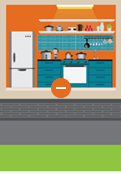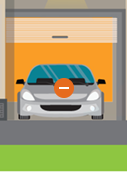Attic, Garage and Unconditioned Spaces
There are many unconditioned spaces in your home – attic, garage, utility room, etc. – which often get overlooked for energy-efficient and conservation measures. Let’s see what we can dig up!
Office and Electronics
In this digital age, electronics are found in every room of the house and many of them have energy-efficient settings. Check out our list below for more information.
Bedroom
Even while you sleep, your home can still use energy. Below we have outlined some tips on saving electricity and staying comfortable without breaking the bank.
Bathroom
This may not be a hot spot for energy efficiency, but there are ways to conserve energy without sacrificing comfort. Check those out below.
Living Room
From lighting to windows to your thermostat, the living room is a great place to make the most out of home energy savings. Read on to see how to reduce electricity bills in your main living space.
Miscellaneous
There are many more ways you can save energy that don’t necessarily fit into one particular room. We have you covered with more tips below.
Kitchen
Even with energy-efficient appliances, you can still learn how to save money on electric bills with the helpful tips you’ll find below.
HVAC – Heating, Ventilation and Air Conditioning
The majority of your energy usage comes from your HVAC system. Below we have outlined numerous tips to help you stay comfortable and maintain your system while lowering your utility bills.
Wondering how to save money on electricity bills? Just follow these tips for conserving energy.
Below you will find simple home energy-saving tips that help you lower your utility bills without sacrificing comfort. Visit our Energy Efficiency Video Library for more in-depth, hands-on examples of some of these tips.
Seasonal ways to conserve energy and reduce utility bills
- Before cold weather sets in, have a licensed HVAC contractor inspect your furnace and ensure it is in proper working order. Cracked heat exchangers could leak harmful gases into the home if not repaired.
- Seal any leaks or drafts around windows and doorways with caulk and/or weatherstripping.
- Plastic window insulation kits help seal draftier windows inside the frame and better prevent heat loss.
- Open blinds/curtains in direct sunlight to help warm rooms by as much as 7 degrees.
- Reversing the rotation of your ceiling fan to clockwise helps push warm air down and out, better distributing it throughout your room.
- Watch our video for ideas on how you can prepare your home for fall and winter.
- Ductwork dampers help balance the airflow and average temperature in your home. If you have no dampers, closing registers is a less efficient option to regulate the temperature room-by-room.
- Adjusting your thermostat by as little as a single degree can increase/reduce energy usage by 1-5%.
- Close the fireplace damper when not in use to avoid heat-loss through the chimney.
- Wood-burning fireplaces are not as efficient as supplemental heat sources as they pull hot air out of your home through the chimney, lowering the overall temperature.
- Open curtains/blinds/shades in direct sunlight to warm rooms during the day and close them at night to reduce heat loss through windows.
- Seal windows/external doors with weatherstripping.
- Have your air-conditioning inspected by a licensed HVAC contractor before warm weather arrives.
- Opening windows on opposite ends of your home promotes natural cooling and fresh airflow.
- Cooking outside when possible is a great way to keep your home temperature low and give your A/C a break.
- Using ceiling/box fans to cool yourself and single rooms with the wind-chill effect is more efficient than constantly cooling your entire home with air-conditioning.
- Make sure ceiling fans rotate counter-clockwise in the warmer months to better cool your spaces.
- Watch our video for ideas on how you can prepare your home for spring and summer.
- Raise your thermostat setting and use ceiling/box fans to cool yourself more efficiently through wind-chill effect.
- Limit yourself to 1 fan per room. Multiple fans (especially box and ceiling fans together) can reduce the wind-chill effect and raise the surrounding temperature.
- Place fans face-out in front of floor or low-on-the-wall registers to help improve airflow.
- Give your A/C unit a break and use heat-generating appliances (dishwasher, clothes dryer, oven, etc.) during cooler parts of the evening.
- Is your thermostat in a hallway? Keep nearby doors open! Closed doors stifle airflow, which can make the sensor think the temperature is higher and run your A/C longer than necessary.
- Close blinds/curtains on south- and west-facing walls to prevent radiative heat from raising the room temperature.
- Be intentional about which doors you use. You could be letting more heat into your home than you realize when entering or leaving – south-facing doorways could be 15 degrees hotter than north-facing doors.
Use your HVAC system efficiently for home energy savings
- Gas furnace flames should be mostly blue. Contact a licensed HVAC technician to inspect your furnace and burners if the flames are not predominantly blue.
- Hire a licensed HVAC contractor to clean and inspect the heat exchanger to prevent possible leakage of dangerous carbon-monoxide gas.
- If you have an air-conditioner (not a heat-pump), keep the fins clear of debris in order to improve its cooling efficiency.
- Keep your chimney flue closed when not using your wood-burning fireplace. Regular chimney inspection/cleaning by a professional is also recommended for safety and efficiency.
- Feel for drafts around window/door frames and seal them off with foam or felt weatherstripping.
- Install door sweeps on any exterior doors to prevent air leakage.
- Seal ductwork with aluminum duct tape or duct mastic-paste at all joints to help prevent air leakage and provide better airflow.
- Clean your AC unit’s fins and exterior to maximize its efficiency. Turn off your unit with the nearby disconnect box or breaker panel and use your garden hose to spray away dirt, dust and other debris.
- Regularly clean your registers with your vacuum’s brush attachment to remove dust, pet hair and other particulates to improve your home’s air quality and HVAC efficiency.
- Raise your thermostat setting and use ceiling/box fans to fine-tune your comfort with the wind-chill effect.
- Is your thermostat in a hallway? Keep nearby doors open! Closed doors stifle airflow, which can make the sensor think the temperature is higher and run your A/C longer than necessary!
- Closing your blind/curtains can reduce the solar-heat gain through windows by as much as 7 degrees.
- Give your A/C unit a break and use heat-generating appliances (dishwasher, clothes dryer, oven, etc.) during cooler parts of the evening.
- Seal your ductwork with UL-certified aluminum-foil tape or mastic paste.
- Clean out the drain/condensation pipes connecting the inside of your A/C system to a drain in the floor. Turn off your HVAC system and pour 1⁄4 cup vinegar + 1⁄4 cup warm water down the pipes to clean out any mold, mildew or mineral buildup.
- Seal ductwork with aluminum duct tape or duct mastic-paste at all joints to help prevent air leakage and provide better airflow.
- Regularly clean your registers with your vacuum’s brush attachment to improve your home’s air quality and HVAC efficiency.
- Ductwork dampers help balance the airflow and average temperature in your home. If you have no dampers, closing registers is a less-efficient option to regulate the temperature room-by-room.
- Keep supply/return air registers clear of obstacles (such as furniture and curtains) to ensure adequate and free airflow.
- Improve airflow in rooms with floor or low-on-the-wall registers by placing fans face-out near them to push air into the area.
- Check filters once a month for discoloration or build-up and replace as needed.
- Make sure your system has a MERV score between 8 and 13. The MERV (Minimum Efficiency Reporting Value) score rates how effective the furnace filter blocks particles and other debris from recycling into the air. 13 is the highest rating most residential systems can withstand before airflow/efficiency is affected.
- MPR and FPR are alternative filter-quality scores. MPR 1900 is equivalent to a MERV 13 rating and FPR 9 or 10 is equivalent to MERV 12.
How to lower home electricity bills throughout the year
- Insulation slows the flow of heat through walls and ceilings. Sitting next to an uninsulated wall makes you feel colder than an insulated wall because your body-heat radiates toward the uninsulated surface and away from you, making you feel colder.
- If your home was built before 1980, you may have inadequate insulation. See if your insulation meets recommended standards for utility savings on the Department of Energy’s Insulation page.
- Make sure your insulation has the proper R-value for your region’s climate. The higher the R-value, the better it prevents heat-transfer, saving you energy. Verify your home's insulation R-value with The Department of Energy's Insulation page.
- Use higher-density insulation, such as rigid foam boards, in cathedral ceilings and on exterior walls.
- Split batts of insulation vertically around cables and pipes to avoid open gaps and improve its ability to properly insulate.
- Don’t compress or over-pack insulation, which can reduce its effectiveness.
- Be sure ductwork in unconditioned spaces (crawl spaces and attics) are either sealed (Video: How to seal your ductwork) or insulated. Installing a radiant barrier in your attic can also help better prevent energy waste.
- Lowering your water heater’s temperature from 140 to 120 degrees could reduce water-heating costs by 5-10%.
- Insulating your water pipes, especially near the water heater itself, can reduce the loss of heat from your hot water pipe, as well as reduce the conduction of heat to your cold-water pipes.
- Insulating water pipes can reduce standby losses up to 4-8 therms (or 150 kWh) for natural gas per year in a single-family home.
- A water-heater Energy Factor [EF] rating indicates its efficiency. The higher the rating, the more efficient the water-heater.
- Fix faucet leaks ASAP! This Drip Calculator shows how much water might be going to waste from a single leaky faucet.
- Low-flow shower heads and faucet aerators can conserve water usage up to 50-60%.
- Adjusting your thermostat as needed is more energy-efficient than maintaining a single temperature all year. Set your thermostat as high as comfortably possible in summer and as low as possible in winter. An increase/decrease by a single degree can save 1% to 5% on energy use.
- During the colder months, keep your thermostat set above 55 degrees to prevent pipes from freezing and rupturing.
- Raising/lowering your thermostat by 5 degrees when leaving your home helps save even more on utility bills.
- Keeping a lower interior temperature in winter and a higher interior temperature in summer slows the transfer of heat into/out of your home, making your HVAC system require less energy.
- Programmable thermostats more efficiently maintain a comfortable climate — even while you’re asleep or away from home. Learn more about Smart Thermostats.
- Make sure your HVAC’s blower is set to Auto, which will only operate when your HVAC system is heating/cooling your home. The On setting keeps the blower running nonstop, which can increase your home’s humidity and require more energy to cool.
- Setting your HVAC system’s blower to On can also add to the humidity of your home if left on for too long. More humidity requires more energy to cool, leading to higher bills in the summer.
- If your thermostat is near heat sources (a bathroom, kitchen, window, etc.), be conscious of how foot-traffic might direct warmer air to the sensor and cycle your air-conditioning unnecessarily.
- Is your thermostat in a hallway? Keep nearby doors open! Closed doors stifle airflow, which can make the sensor think the temperature is higher and run your A/C longer than necessary.
- LED bulbs consume 20-30% less than energy CFLs and 80-90% less energy than incandescent bulbs.
- LED bulbs can last up to 25,000 hours; CFLs up to 12,000 hours; incandescent bulbs last roughly 750 to 1,200 hours. They also come in a spectrum of sizes, brightness, colors and applications to customize the feel of every area in your home.
- Replacing a 60-watt incandescent bulb with an equivalent LED 9-watt bulb can save you over $1.50 per month, per bulb.
- Make sure to use dimmable LED bulbs in dimmable sockets – using non-dimmable bulbs can cause flicker and reduced lifespan.
- Getting rid of your CFL bulbs? Properly and safely dispose of your old bulbs.
- Be intentional about shutting off the lights any time you leave a room empty.
- Use motion sensors or motion-sensing lightbulbs for outdoor lighting whenever possible.
- Give your A/C unit a break and use heat-generating appliances (dishwasher, clothes dryer, oven, etc.) during cooler parts of the evening.
- Smart strips help you easily turn off multiple idle appliances at once and reduce phantom load.
- Clean/dust the coils for your refrigerator at least once a year. Coils are typically located at your refrigerator’s base or on the back behind a grate. Unplug your refrigerator prior to cleaning and plug it back in once finished.
- 90% of energy consumed from washing machines is due to use of heated water. Reduce your electricity bill by washing your laundry with cold water whenever possible.
- Take advantage of your dryer’s moisture sensor (if applicable), which prevents you from over-drying clothes and wasting energy.
- Maximize food-storage efficiency by keeping your fridge between 30-40 degrees and the freezer between 0-5 degrees.
- Keep your fridge/freezer door seals clean and monitor internal temperatures with a thermometer to improve efficiency and prevent food spoilage.
Last updated: 9/3/2021






















